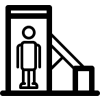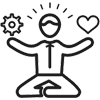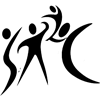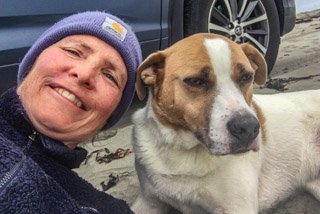Life Purpose
Life Purpose
This Total Health area addresses our bigger reason for being here. Do you set personal, family, or business goals? What matters most to you? What values or principles do you follow that help you make hard decisions?

How can taking a five-minute action help? It creates a tiny bit of positive momentum that helps you get unstuck. You’re probably thinking, “But clutter-busting my house will take weeks, maybe even months.” Or maybe, “That’s ridiculous. I can’t prepare to climb Mt. Rainier in five minutes.” And trust me, I’ve said it myself: “There’s no way I can even think about writing a book in five minutes.”
I hear you.
BUT… what five-minute action COULD you take that will get you one step closer to your goal?
Let’s use this article as an example. It was once on my “shortlist”, but it was not my “one thing.” Until the day it became the ONE THING I had to do. Yet, I still couldn’t get started.
Finally, I reminded myself to pick a five-minute task. It could be anything. I chose to look for some photographs to go with my blog post.
Before I knew it, I had chosen pictures that represented different aspects of taking a five-minute action. Then, I came up with several headings. I wrote my first paragraph. And an ending. Before long, I had written half the blog. All it took was committing to taking one five-minute action.

A trick I explored recently is looking at negative or stressful events in a new way, called reframing. Before you say, “I don’t want to read about dread, worry, anxiety, and bad habits. Just teach me how to get unstuck!” consider this: what if we look at them as coping strategies that are simply trying to help us?
Every habit is there to serve a purpose. If we reframe our view of “bad habits” into something that is trying to help us, we can find substitutions and lessen their power over us.
When you have a bad experience, try asking yourself open-ended questions to find the “silver lining.” Perhaps you learned something new about yourself. Or you met someone kind and helpful you might not have otherwise met. Maybe you learned how imperative it is to never have that same experience again.
An “open-ended question” is one that cannot be answered with simple one-word responses such as “yes, no, or maybe.” Such questions require deliberate thought, usually phrased with words like who, what, where, when, and how. Some examples might include, “How might you view that experience in a way that doesn’t increase anxiety?” or “What takeaway lesson did you learn about yourself or others that might help you in the future?”

Are you sick of saying you’re going to change but never doing it? Are you really sure you’re ready? Then learn how to get massive leverage on yourself, once and for all, so that the change sticks.
Think of change as a series of stepping stones. You cannot cross any river (metaphorical or actual) without taking the first step. What is the first step you need to take to get massive leverage on yourself?
Are You Ready to Change?
In order to change a bad habit for good, you need to meet the following criteria:
- Be RAW — Ready, Able, and Willing — to change
- Know exactly what behavior you want to eliminate and what you want to replace it with
- Have a supportive community
- Make it so that keeping the old habit becomes more painful than creating a new one
Let’s take a look at each, including my own experience with massive leverage. And at the end of reading, if you are inspired to change, let’s talk about what that will look like for you.

What do you hope to accomplish in the next six months? Is this the year you commit to losing weight? Is now the right time to ditch a job you hate and find your dream job? Whatever your goal, NOW is the only time you will ever have to determine what’s most important to you and put a plan into action to accomplish your goals.
The example given below is designed to make you think more seriously about setting goals. In order to reach any goal, whether it is related to business, family, health, fitness, education, or something else entirely, you need to make sure you do five things.
First, make your goals as specific as possible. Make sure the goals are measurable, so you know when you have reached them and can move on to others. Keep them action-oriented, so you have a plan of attack to make each goal become reality. Keep them realistic so you don’t get discouraged and lose your motivation. Finally, give them a time stamp so that you commit to action and follow through.

When my daughter was a senior in high school, she faced a variety of hard choices: where should she apply to college? what should she study? did she want to take Driver’s Ed? Did she want to look for a summer job? When faced with a large number of options, how do you start narrowing them down?
How to Start Narrowing Down
What if you have a number of things you want to change? If you want to improve your diet, start a different job, move forward in an important relationship, grab some new travel opportunities, expand your friendship circle, interact more with family members, and improve your physical health, where do you start?
If you tried tackling everything at once, you would fail at all of them. What do you do if you want to change everything? It might help to first pick THE MOST IMPORTANT GOAL (whatever is weighing most heavily on your mind) and to provide yourself with a structure to explore it.
Whenever I face a blank page, it is easier to write if I’m given a prompt, an idea, or a structure within which to write. Take blogging: I limit myself to eight photos, keep my word count between 800-1200 words, and stick to the same format I’ve used during the past fifteen months. I also tie whatever I write to the broad topic of moving forward and getting unstuck. Such scaffolding provides me with structure and coherence, and it provides my readers with continuity from post to post.

Are you constantly thinking, “I should be doing X” or “Why can’t I ever do Y?” If so, you are not alone. And there is hope! The way to make progress lies in focusing carefully, using positive self-talk, and resetting your expectations.
Focus Carefully
For anyone who is constantly fixated on that little number on a scale, remind yourself of one very simple truth. Ready? YOU ARE SO MUCH MORE THAN YOUR BODY MASS. Print it in triplicate in 72-point font and hang it up everywhere you need a reminder. Scales don’t know your BMI, cannot ascertain how much muscle you have, and know zero about all of your outstanding personal qualities. The scale only tells you ONE tiny bit of information, and yet so many of us obsess over that number. If you rely on the scale reading every single morning, ask yourself why.
Whenever you have a medical appointment and your doctor insists on weighing you, explain that you are trying to have a healthier relationship with your body and want to break the scale habit. Face the opposite direction and ask the doctor not to tell you the number. And if your doctor cannot respect that, find one who will. The media tries to get us to obsess about our exterior looks, but what about the rest of us? If you have great bloodwork, healthy blood pressure, and a consistent movement routine, then celebrate that. Forget about the scale for now!

Earlier this summer, my husband, teenage daughter, and I went on three different outings: disc golf, pickleball, and birding. All three are mild physical activities, done outside, and require different skill sets. They also provided me with a wonderful insight into how important it is to maintain a beginner’s mindset for optimal fun.
Disc Golf Reminded Me of the Value of a Beginner’s Mindset
We started with a “practice hole” at North Park since our daughter had never played before. I wasn’t sure how my right wrist would do, since I was still rehabbing it from a break four months earlier. My first throw went perpendicular to the intended direction. I have zero control. I’ll have to throw leftie. Unfortunately, I pitched the next disc into the street. Mortified, I considered walking the entire course as a spectator. Not once did I think, With my injured wrist, it’s like I am a complete novice. Better change strategies.
Meanwhile, my husband (who has played a lot of golf and disc golf) reached the chain basket in 3 throws. Me? Try twelve. I used to be able to throw much harder and farther. I can’t win; I can’t even compete. My wonky throwing will only slow us down.

After I broke my wrist on February 22, 2022, during our vacation in Moab, I found it difficult to feel anything close to joy. At times I struggled to do everything left-handed while enduring the pain. But once I got over the initial discomfort and overwhelm, I began hunting for what makes me feel light and content.
As a family, we listened to Ingrid Fetell Lee’s book on CD, Joyful: The Surprising Power of Ordinary Things to Create Extraordinary Happiness. In it, she introduces ten aesthetics of joy. What makes you say “Yay” or “Wow”? Can you hold your own joy treasure hunt?

In her book Rising Strong, Brene Brown uses a powerful phrase that resonates as much for me as advice from the Gap and the Gain. Brown, a shame researcher, talks about falling down and finding the courage to reset ourselves so we can get back up again.
Anytime we feel exceedingly vulnerable when asking for what we need, she suggests using the phrase: The story I’m telling myself… Read on to find out more about how to use her line to move forward.
Brene Brown’s Lake Travis Story
As an example of how this line works, Brown shares a story about swimming in Lake Travis with her husband Steve. In it, she tries several times to connect with him on a deep, spiritual level, without getting the desired (i.e. expected) response.
The fiction she creates in her mind is that she’s too slow. Or that her husband doesn’t like how she looks in her swimsuit. Perhaps he no longer felt connected to her after years of marriage.
Meanwhile, his own story involves dwelling on a recent nightmare about losing the kids in a boating accident. While he is preoccupied with trying to remain the strong, capable, heroic man he thinks she wants him to be, she’s trying to connect.
When they finally talk about it later, she uses the phrase, “The story I’m telling myself…” It signals that she feels vulnerable, tentative, and aware that she may have created a false narrative.
They both share their own interpretation of the moment. As a result, they weather the rough spot with greater understanding and appreciation for each other.





